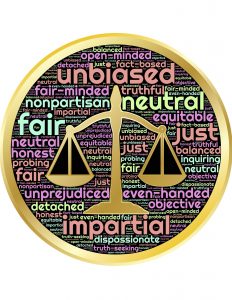Even with good performance, women struggle to get promoted and risk derailment

In a perfect world, performance and potential would drive decisions about promotions. The best candidate would get the job.
Reality shows that for women barriers persist at work regardless of strong performance. Women struggle to get promotions and face harsher consequences for mistakes.
Research shows barriers at work
The gender bias stubbornly continues. Women must work harder under more risk to accomplish as much as a similarly skilled man.
The studies covered in this article agree that women, as a whole, perform equal or better at core job tasks and on leadership skills than men.
Regardless of strong performance, women struggle to get promoted. Men also receive more tolerance for mistakes which leads to a higher likelihood of women derailing in their careers.
Two papers regarding gender and barriers at work

These disturbing patterns appear in many research studies.
This article summarizes results from two papers involving thousands of leaders that address differences in performance, career derailment and leadership behaviors between men and women.
In the first 2017 paper from Personnel Psychology titled ‘Dropped on the Way to the Top: Gender and Managerial Derailment‘, Bono, Braddy, Liu, Gilbert, Fleenor, Quast and Center considered four studies that examined performance and likelihood of career derailment for men and women.
The second paper from Harvard Business Review online in 2019 by Zenger and Folkman titled ‘Research: Women score higher than men in most leadership skills‘ also researched performance and identified differences in specific leadership behaviors.
Paper 1: Research Overview
The Bono paper combined data and findings from four different studies that included about 38,000 people across different organizations and used various assessments.
Two of the studies leveraged existing data of thousands of leaders from 360 feedback assessments. The other two studies involved experiments to mimic situations and try to replicate the findings.
The variety of data and methods provides a solid foundation for these findings.
Paper 1: Research Findings
Women and men have similar performance

The research found that performance review scores show men and women performing at similar levels.
This equality in performance does not translate into equality in ongoing opportunities. Men continue to get rated higher on promotional opportunities and get more rewards, regardless of the equal performance.
This shows a double standard. Women must perform at a higher standard than men to be promoted.
Women tend to have more effective leadership behavior
Evidence indicates that women are more likely to have effective leadership behavior than men.
Raters in 360 assessments (bosses, peers, and direct reports) consistently give higher scores to women on leadership skills such as being adaptable to different types of people and works to get people on board with decisions.
Even out-performing men on leadership behaviors does provide security or opportunities for women.
Most leaders go through challenging periods when they struggle with behaviors or leadership skills. Maybe a leader got promoted too quickly or has a personality conflict with a boss or does not have the needed skills.
Although men and women both experience these challenging periods, their outcomes are very different.
Ineffective behavior is often excused for men while women face high risk of having their careers derail.
Women are 17% more likely to derail their careers
Career derailment leaves women stuck in role or even ends their career.
The researchers define derailment as occurring when a manager fails to achieve an expected career outcome and is involuntarily demoted, fired or plateaued without reaching the level expected of them.
The first study covered in the Bono paper used 360 feedback data from over 12,000 leaders to compare risk of career derailment for men and women due to ineffective behaviors.
They found that women are 17% more likely to derail than men for similar types of ineffective personal behavior.
Women are 17% more likely to derail for the same issues
Jennifer and Jason proved the double standard

The researchers replicated this finding by conducting two research experiments – one done with 160 US managers and one done with 180 reviewers from Mechanical Turk.
The reviewers examined and rated reports for a manager with varying levels of interpersonal behaviors and performance ratings. The reports were identical in every way – except one was for “Jennifer” and the other was for “Jason”.
Regardless of identical details (except for name), raters consistently indicated that Jennifer would be more likely to derail in her career.
Gender alone made Jennifer more likely to derail than Jason.
Women lose sponsors when struggling which accelerates derailing
Ineffective behaviors can lead to derailment for men or women. So why are women 17% more likely to derail?
When ineffective behavior occurs, the bosses start to worry about the leader. Worry about derailment can lead to withdrawing of mentoring and sponsorship, because the boss does not want to be associated with a manager who derails.
Since people rate women higher at risk of derailing for similar issues, women are more likely to lose mentors and sponsors. This further accelerates their career derailment.
It becomes a vicious cycle. Women and men perform at similar levels and women outperform men on leadership skills. But when men and women show less effective interpersonal skills, men are excused and women are penalized. Support is withdrawn due to fears of derailment – again hitting women harder.
Paper 2: Overview and Findings
In addition to the four studies covered in the Bono paper, Jack Zenger and Joe Folkman wrote an article in Harvard Business Review (HBR) on June 25, 2019 called ‘Research: Women score higher than men in most leadership skills’ detailing similar findings.
Women demonstrate better leadership

Also using results from 360-degree reviews, Zenger and Folkman share results that show women scoring higher on the vast majority of leadership skills.
Even so, the troubling fact is that women still comprise only a small part of the Fortune 500 CEOs (4.9%). Women demonstrate ability and competence, yet opportunities are still denied.
Based on thousands of 360 reviews, they found that women outscored men on 17 of 19 capabilities such as Takes Initiative, Resilience, Drives for Results and Displays High Integrity and Honesty.
By contrast, men only scored higher on 2 of 19 – Technical or Professional Expertise and Develops Strategic Perspective.
They attribute the disconnect between skills and status partially to stereotypes and unconscious bias.
Applying This Research
These research studies provide ample evidence that women still face barriers at work. Since these barriers likely result from unconscious bias, it requires dedicated attention and programs to tear down the barriers.
Here are some thought starters and possible actions.
Recognize the broad and local patterns of barriers at work

This research provides a broad generalized pattern. It examines men and women as groups and looks for patterns in the data.
Those general patterns do not necessarily reflect your individual experience and workplace.
Similarly, individual people will perform differently. Some men will perform better than some women and some women will receive promotions and opportunities.
For your company, examine your ‘local’ pattern. Ask probing questions such as “are you or your organization holding women to higher standards than men?.”
Make bias visible
One reason this pattern of barriers at work persists is that leaders don’t recognize their own bias or the bias built into their processes. Step back and bring visibility to bias by monitoring how employees are discussed and through tracking and reporting.
Focus on comparing results and behaviors when comparing leaders. If you rely on generalities (like “he’s a good guy”) and intuition, unconscious bias is likely to creep into the discussion.
Create visibility of gender during succession planning. Add a step to every discussion to ensure that every person was discussed in a fair way.
Monitor the talent pipeline to track gender at all levels in the organization. Often there is a level at which the percentage of women starts to rapidly decline. Identify the pattern for your organization and get to the root cause.
Purposefully include women in development
When tapping leaders for special development programs or stretch opportunities, review the list with an eye toward diversity. Make sure the candidate list includes a diverse range of qualified candidates before making your decision.
Work to pair women up with mentors and sponsors to help them navigate organizational politics and to provide an early warning system if they seem to be derailing. Equip these mentors with the skills to coach women through missteps and issues.
Conclusion
Research shows that real barriers exist for women in the workplace. As a society, we need the skills and talents of all of our employees. For the benefit of all, we must acknowledge the data, understand the problem and level the playing field.
Research Details
Bono, J.E., Braddy, P.W, Liu, Y., Gilbert, E.K., Fleenor, J.W., Quast, L.N. and Center, B.A. (2017). Dropped on the way to the top: Gender and managerial derailment, Personnel Psychology, 70, 729-768. https://onlinelibrary.wiley.com/doi/abs/10.1111/peps.12184
Zenger, J. and Folkman, J. (June 25, 2019) ‘Research: Women score higher than men in most leadership skills‘. HBR.org.
Researchers: Paper 1
Joyce E. Bono, University of Florida
Phillip W. Braddy, Center for Creative Leadership
Yihao Liu, University of Florida
Elisabeth K. Gilbert, University of Florida
John W. Fleenor, Center for Creative Leadership
Louis N. Quast, University of Minnesota
Bruce A. Center, University of Minnesota
Researchers: Paper 2
Jack Zenger, Zenger Folkman
Joe Folkman, Zenger Folkman



